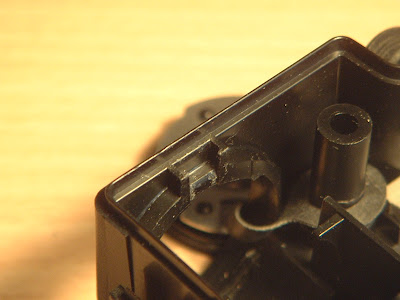Although the THS7BAT pack simply comprises four NiCd 'C' cells in series, it isn't straightforward to copy. The construction is unusual, with the top positive connection brought down the side of the cells in a thin metal strip to a circumferential contact band near the negative end. This is probably designed to prevent the pack making contact if inserted the wrong way round, but it makes the pack unique and therefore expensive.
I thought it would be a good idea to modify the scope to use a set of normal rechargeable cells. These are relatively cheap, easy to obtain, and charging cells individually is likely to provide them with a longer life than a series connected pack. Also, as a bonus it gives the option to use primary cells in an emergency.
Battery Compartment Modifications:
Adjacent to the bayonet fitting in the case there is a moulded feature which looks suspiciously as though it once might have been designed to house such a contact. All that was needed was a small piece of aluminium and a phosphor bronze strip (cut from an old battery housing).
The aluminium simply slots into the feature and is held held in place by the top half of the case, while the phosphor bronze is bolted to it and suitably shaped to provide a wiping connection. The original positive side contact is removed.
So what sort of cells to use ? The 2.8AH capacity of the original 'C' cells can now be obtained in 'AA' cells (in both NiMH and NiCd). 'C' cells are available in higher capacities but are relatively expensive, so it seemed reasonable to allow for the use of the smaller 'AA' cells.
Rather than modify the battery compartment I decided to use cheap clip-on 'AA' to 'C' converter tubes, thus leaving the option to use 'C' cells if required.
Although the Tek pack may eventually become difficult to obtain and even more expensive as demand reduces, 'AA' and 'C' cells of one sort or another are going to be around for very long time...
Charging:
A straightforward solution was to disable the internal charging, and rely solely on external chargers. For many jobs several battery changes might be required and the internal charger is then of no use anyway. The potential hazard of connecting the mains adaptor with primary cells fitted is also avoided.
Implementation:
Initially this relay was wired directly to the external PSU connector. However, if the PSU lost mains supply with the scope powered up, the relay held on down to a rather low voltage and failed to reconnect the battery in time to prevent a re-boot. This wouldn't have been so bad but for the fact that many user settings are lost if the scope isn't shut down tidily via the on/off button (or automatically when the battery voltage falls slowly down to 4.4V).
The final circuit uses a zener and a transistor to ensure the relay drops out as soon as the PSU voltage drops below approx. 9V. The slow response of the relay still results in a re-boot if the PSU jack is simply pulled, but none occurs on loss of mains voltage, where the capacitance in the PSU slows the voltage drop sufficiently for the battery to take over in time. (It does however mean that the battery will receive charging current if the PSU volts should lie between approx. 5V and 9V.)
As a final safeguard a 'crowbar' diode and 2A fuse protect the scope in the (hopefully unlikely!) event that the batteries are inserted the wrong way round - this fuse is soldered in-line and inconvenient to replace, but better safe than sorry...
Other Issues:
There has always been a design problem in removing the bayonet cap if there was no battery pack present to push it out - the cap has no feature to grip and pull on. This was solved by making an insulated rod of the appropriate length to insert in place of batteries while the scope is stored or just running from the external PSU.
Conclusion:
Barrington 14/03/12





